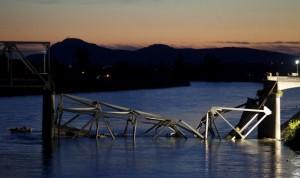InfrastructureNumber of structurally deficient bridges in U.S. declines
The number of structurally deficient bridges in the United States has declined by 14 percent in the last six years, but despite the improvement, 10 percent of American bridges are in need of maintenance, rehabilitation, or replacement. The average age of bridges in the country is forty-three years old, and most bridges were built to last for fifty-years, so eventually all bridges will become structurally deficient unless they are repaired or replaced.

Bridges are improving, but there will be more becoming deficient // Source: alalam.ir
The number of structurally deficient bridges in the United States has declined by 14 percent in the last six years, but despite the improvement, 10 percent of American bridges are in need of maintenance, rehabilitation, or replacement.
“There has been a renewed focus and increased attention paid to bridges,” said Robert Victor, head of an American Society of Civil Engineers’ group that evaluates the state of the country’s infrastructure.
Structurally deficient bridges must be inspected annually because one or several of their load-carrying components are in poor conditions, so officials often divert large trucks from crossing them.
Governing reports that Oklahoma, Missouri, Texas, Mississippi, Pennsylvania, and Ohio have made the biggest improvements in the last six years in reducing structurally deficient bridges. All six states were responsible for 57 percent of the decrease in structurally deficient bridges nationwide, but engineers warn of making state-to-state comparisons as bridges in regions with harsher winter climates are likely to suffer more over time.
The 2007 collapse of the I-35W Mississippi River Bridge in Minneapolis, in which thirteen people died, sparked a public outcry and forced state engineers to review bridge safety. Since the Minneapolis bridge collapse, Oklahoma reduced its number of structurally deficient bridges by more than 1,700, but Terri Angier, a spokeswoman for the Oklahoma Department of Transportation, said the state has been working on bridge improvement ever since fourteen people died in a 2002 Oklahoma bridge collapse.
Legislative policies have also encouraged states better to manage their inventory of bridges. Congress’s 2012 Moving Ahead for Progress in the 21st Century Act (MAP-21) allocated roughly $105 billion toward road improvements; but states could suffer more troubled bridges if they lose funding for future transportation projects as the act expires on 30 September 2014.
In Oklahoma, annual road budget will increase to $775 million by 2018, from just $200 million a year in 2005. 2014’s road budget is roughly $500 million.
Since the Minneapolis bridge collapse, Vermont and Utah have reduced their number of structurally deficient bridges by more than half; and Minnesota had seventy-two fewer structurally deficient bridges in 2013 than in 2007. Despite the improvements, much more work is needed on the nation’s bridges. Nebraska, Connecticut, Arizona, Idaho, Wyoming, Louisiana, Delaware, North Carolina, and Maine have together accounted for an increase of 644 structurally deficient bridges since the Minnesota bridge collapse.
Delaware and Arizona had the highest percentage increase in the number of structurally deficient bridges, but that is because both states had so few structurally deficient bridges to begin with. In 2007, Delaware and Arizona had the lowest percentage of structurally deficient bridges of any states.
Experts note that the average age of bridges in the country is forty-three years old, and most bridges were built to last for fifty-years, so eventually all bridges will become structurally deficient unless they are repaired or replaced.
